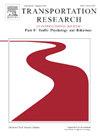是失去控制还是不失去控制?法国骑自行车者的冒险和事故参与的心理社会预测因素的比较
IF 3.5
2区 工程技术
Q1 PSYCHOLOGY, APPLIED
Transportation Research Part F-Traffic Psychology and Behaviour
Pub Date : 2025-02-25
DOI:10.1016/j.trf.2025.02.024
引用次数: 0
摘要
尽管骑自行车有很多好处,但骑自行车的人是特别脆弱的道路使用者。致命和严重伤害限制了自行车运动的发展,这可以归因于几个因素,包括自愿和非自愿的危险骑自行车行为。本研究旨在调查和比较文献中与冒险相关的一些社会心理变量的作用,但在骑自行车者中研究较少:一般风险倾向、冲动性、寻求刺激、对违规和冒险骑自行车的描述性和强制性社会规范,以及对骑自行车者交通规则的合法性的感知。风险感知也被包括作为一个竞争变量。问卷调查由大量法国自行车运动员(排除后N = 1,650)完成。危险的骑行行为被认为是根据自我报告的违规频率,错误,不戴头盔,以及参与过去的车祸受伤。潜在的预测因素、危险行为和车祸之间的关系首先通过双变量分析进行了检验,然后通过多变量分析进行了确认。最后,进行了中介分析,以检验潜在预测因素通过风险行为对过去崩溃的间接影响。主要发现强调了稳定的个人倾向(即一般风险倾向,紧迫感作为冲动的一个方面)和更具可塑性的个人感知(即描述性规范,交通规则的合法性)在危险骑行中的作用。禁令规范和风险感知与风险循环的相关性较弱或不相关。讨论了未来研究的局限性、前景以及基于证据的道路安全干预措施的发展(例如,情绪调节培训、强调危险行为不会带来预期的社会心理利益的运动)。本文章由计算机程序翻译,如有差异,请以英文原文为准。
To lose or not to lose one’s grip? A comparison of psychosocial predictors of risk-taking and accident involvement among French cyclists
Despite the many benefits of cycling, cyclists are particularly vulnerable road users. Fatal and serious injuries limit the development of cycling and can be attributed to several factors, including voluntary and involuntary risky cycling behaviors. This study aims to investigate and compare the role of some psychosocial variables associated with risk-taking in the literature but still little studied among cyclists: general risk propensity, impulsivity, sensation-seeking, descriptive and injunctive social norms towards violations and risky cycling, and perceived legitimacy of cyclists’ traffic rules. Risk perception was also included as a competing variable. A questionnaire was completed by a large sample of French cyclists (N after exclusions = 1,650). Risky cycling behaviors were considered in terms of self-reported frequency of violations, errors, not wearing a helmet, and involvement in past crashes with injuries. Associations between potential predictors, risky behaviors and crashes were first examined using bivariate analyses and then confirmed using multivariate analyses. Finally, mediation analyses were conducted to test indirect effects of potential predictors on past crashes through risky behaviors. The main findings highlight the role of stable individual dispositions (i.e., general risk propensity, urgency feeling as a facet of impulsivity) and more malleable individual perceptions (i.e., descriptive norms, legitimacy of traffic rules) in risky cycling. Injunctive norms and risk perceptions were weakly or not associated with risky cycling. Limitations, perspectives for future research and for the development of evidence-based road safety interventions (e.g., emotion regulation training, campaign highlighting that risky behaviors does not bring the expected psychosocial benefits) are discussed.
求助全文
通过发布文献求助,成功后即可免费获取论文全文。
去求助
来源期刊
CiteScore
7.60
自引率
14.60%
发文量
239
审稿时长
71 days
期刊介绍:
Transportation Research Part F: Traffic Psychology and Behaviour focuses on the behavioural and psychological aspects of traffic and transport. The aim of the journal is to enhance theory development, improve the quality of empirical studies and to stimulate the application of research findings in practice. TRF provides a focus and a means of communication for the considerable amount of research activities that are now being carried out in this field. The journal provides a forum for transportation researchers, psychologists, ergonomists, engineers and policy-makers with an interest in traffic and transport psychology.

 求助内容:
求助内容: 应助结果提醒方式:
应助结果提醒方式:


